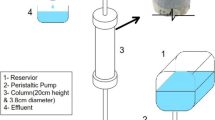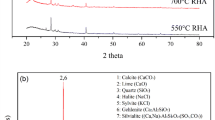Abstract
In the past decade more attention has been paid to storm waters as well as urban runoff as a new source of water. While these waters can be effectively used, one should remove their unwanted pollutants; thus the effect of mix design factors on removal of Cu and Ni from aqueous solution was investigated. For this purpose a fractional factorial experiment was used and the results were analyzed and optimized by using Minitab 17 software. Subsequently, appropriate amounts of natural zeolite, iron oxide and superplasticizer were optimized by Response Surface Methodology (RSM), with the goal of maximizing Cu and Ni removal as well as increasing permeability and minimizing the cost of concrete construction. The optimum mix design of pervious concrete includes pumice aggregate (grain size between No. 4 ∼ No. 3/8” sieve), W/C (0.25), A/C (4), 100 Kg Portland cement per cubic meter of concrete, silica fume (5.05 percentage of cement weight), zeolite (5.45 percentage of cement weight), iron oxide (0.5 percentage of cement weight), and superplasticizer (0.11 percentage of cement weight). Verification samples indicated 69% Ni removal, 84.5% Cu removal, the compressive strength of 2 MPa and permeability coefficient of 1.6 cm/s.
Similar content being viewed by others
References
Dierkes C, Holte A, Geiger W (2000) Heavy metal retention within a porous pavement structure. University of Essen , Essen
Sansalone J, Buchberger S (1996) Characterisation of solid and metal element distributions in urban highway stormwater. In: Seventh international conference on urban storm drainage hannover
Grottker M (1987) Runoff quality from a street with medium traffic loading. Sci Total Environ 59:457–466
Damodaram C, Giacomoni M, Khedun C, Holmes H, Ryan A, Saour W, Zechman E (2010) Simulation of combined best management practices and low impact development for sustainable stormwater management. J Amer Water Resour Assoc 46(5):907–918
Strecker E, Urbonas B, Jones J, Clary J (2001) Dermining urban storm water BMP effectiveness. J Water Resour Plann Mang 127(3):144–149
Kauffman G, Brant T (2000) The role of impervious cover as a watershedbased zoning tool to protect water quality in the christina basin of delaware,pennsylvania, and maryland. In: Proceedings of the water environment federation conference. Vancouver, Canada
NRMCA (2006) Ready Mixed Concrete Industry LEED Reference Guide, Silver spring, http://www.rmc-foundation.org
Montes F, Haselbach L (2006) Measuring hydraulic conductivity in pervious concrete. Environ Eng Sci 23(6):960–969
Lian C, Zhuge Y (2010) Optimum mix design of enhanced permeable concrete – An experimental investigation. Constr Build Mater 24:2664–2671
Putman B, Neptune A (2011) Comparison of test specimen preparation techniques for pervious concrete pavements. Constr Build Mater 25:3480–3485
Shu X, Huang B, Wu H, Dong Q, Burdette E (2011) Performance comparison of laboratory and field produced pervious concrete mixtures. Constr Build Mater 25:3187–3192
Ghafoori N, Dutta S (1995) Laboratory investigation of compacted no-fines concrete for paving materials. J Mater Civil Eng: 183–191
Zheng-wu J, Zhen-ping S, Pei-ming W (2005) Effects of some factors on properties of porous pervious concrete. Journal of Building Materials
Kevern J, Schaefer V, Wang K, Suleiman M (2008) Pervious concrete mixture proportions for improved freeze-thaw durability. J ASTM Int 5(2):521–533
Joshaghani A, Ramezanianpour A, Jaberizadeh M (2014) Mechanical characteristic of pervious concrete considering the gradation and size of coarse aggregates. Res J Environ Earth Sci 6:437–442
Loimula K, Kuosa H (2013) The impact of pervious pavements on water quality State-of-the-Art, VTT Technical Research Centre of Finland, Project Num 79524
Moraci N, Calabrò P (2010) Heavy metals removal and hydraulic performance in zero-valent iron/pumice permeable reactive barriers. J Environ Manag 91:2336–2341
Park S, Tia M (2004) An experimental study on the water-purification properties of porous concrete. Cement Concr Res 34:177–184
Scholz M, Grabowiecki P (2007) Review of permeable pavement systems. Build Environ 42:3830–3836
Sonebi M, Bassuoni M (2013) Investigating the effect of mixture design parameters on pervious concrete by statistical modelling. Constr Build Mater 38:147–154
Martin C, Ruperd Y, Legret M (2007) Urban stormwater drainage management: The development of a multicriteria decision aid approach for best management practices. Eur J Oper Res 181:338–349
Vázquez-Rivera NI, Soto-Pérez L, St John JN, Molina-Bas OI, Hwang SS (2015) Optimization of pervious concrete containing fly ash and iron oxid nanoparticles and its application for phosphorus removal. Constr Build Mater 93:22–28
Montgomery D, Runger G, Hubele N (2011) Engineering statistics, 5th edn. Arizona State University, Wiley
Foroughi M, Khiadani M, Amin MM, Pourzamani HR, Dastjerdi M (2013) Treatment of synthetic urban runoff using manganese oxidecoated sand in the presence of magnetic field. Int J Environ Health Eng 2(2):1–5
Pitcher S, Slade R, Ward N (2004) Heavy metal removal from motorway stormwater using zeolites. Sci Total Environ 334–335: 161–166
Phuengprasopa T, Sittiwong J, Unobb F (2011) Removal of heavy metal ions by iron oxide coated sewage sludge. J Hazard Mater 186:502–507
Ok Y, Yang J, Zhang Y, Kim S, Chung D (2007) Heavy metal adsorption by a formulated zeolite-Portland cement mixture. J Hazard Mater 147:91–96
Ahmadi B, Shekarchi M (2010) Use of natural zeolite as a supplementary cementitious material. Cement Concr Compos 32:134–141
Ramezanianpour A, Kazemian A, Sarvari M, Ahmadi B (2013) Use of natural zeolite to produce self-consolidating concrete with low portland cement content and high durability. J Mater Civ Eng 25(5):589–596
Catalfamo P, Arrigo I, Primerano P, Corigliano F (2006) Efficiency of a zeolitized pumice waste as a low-cost heavy metals adsorbent. J Hazard Mater B134:140–143
Kevern J, Wang K, Suleiman M, Schaefer V (2005) Mix design development for pervious concrete in cold climates. In: Proceeding of the 2005 mid-continent transportation research symposium. Ames
Yang J, Jiang G (2003) Experimental study on properties of pervious concrete pavement materials. Cement Concr Res 33(3):381–386
Assaad JJ, Harb J (2013) Use of the falling-head method to assess permeability of freshly mixed cementitious-based materials. J Mater Civ Eng 25(5):580–588
Najimi M, Sobhani J, Ahmadi B, Shekarchi M (2012) An experimental study on durability properties of concrete containing zeolite as a highly reactive natural pozzolan. Constr Build Mater 35:1023–1033
A. C. I. C. 5. ACI (2010) Report on Pervious concrete, American Concrete Institute, Report No. 522R-10., Michigan
Author information
Authors and Affiliations
Corresponding author
Rights and permissions
About this article
Cite this article
Yousefi, A., Matavos-Aramyan, S. Mix Design Optimization of Silica Fume-Based Pervious Concrete for Removal of Heavy Metals from Wastewaters. Silicon 10, 1737–1744 (2018). https://doi.org/10.1007/s12633-017-9663-5
Received:
Accepted:
Published:
Issue Date:
DOI: https://doi.org/10.1007/s12633-017-9663-5




